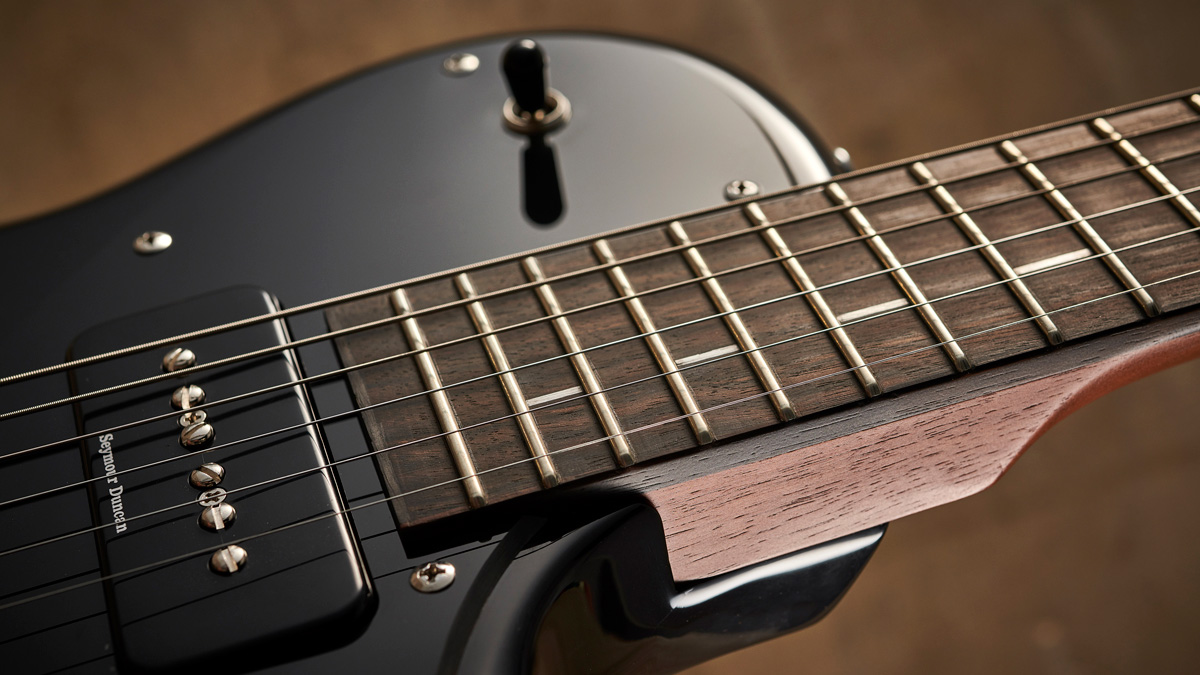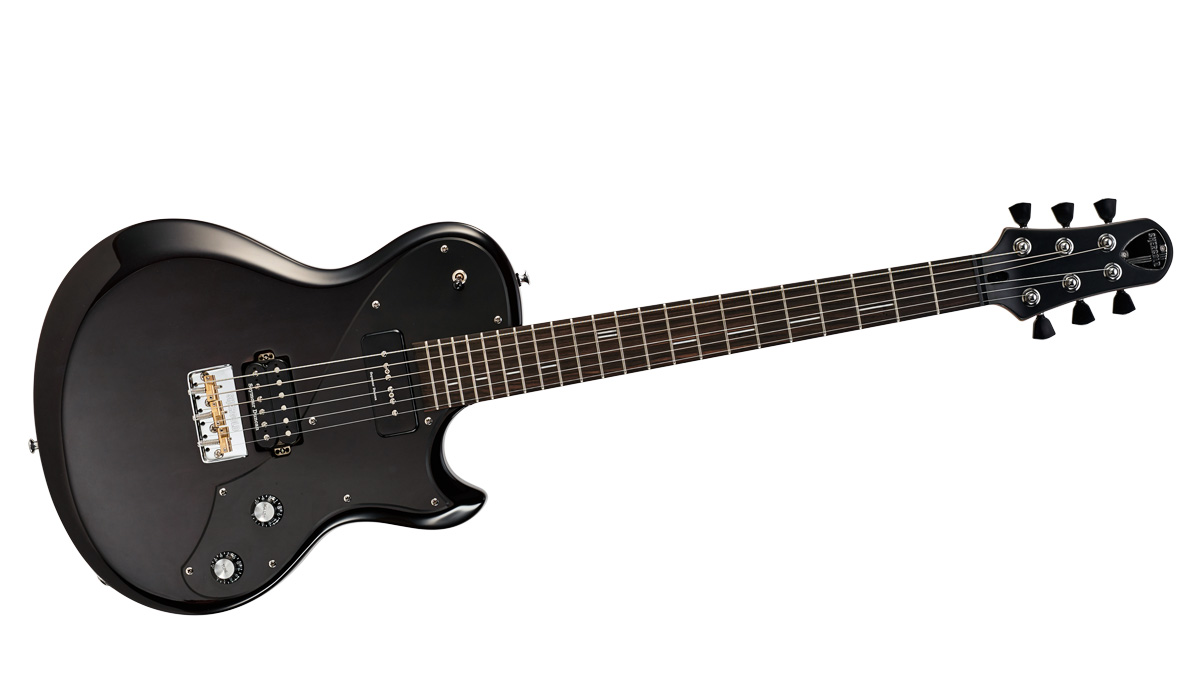MusicRadar Verdict
This is a classy guitar with an eye on budget that feel, play and sound anything but.
Pros
- +
Quality build, hardware and pickups with excellent range of sounds.
- +
Pearly Gates/P-90 combo.
Cons
- -
Direct-mount bridge pickup doesn’t allow easy adjustment.
- -
Coil-split on bridge humbucker is rather thin-sounding.
- -
No gigbag.
MusicRadar's got your back
Bringing a far-from-classic brand such as Shergold back to market was always going to be an uphill struggle.
Slavishly recreating the original designs - which were, at best, functional - clearly wasn’t an option for any kind of modern mainstream success. And while the new-design Masqueraders have been doing rather nicely and certainly bring some serious quality and style to the market, some have dismissed the guitar as a rather ugly duckling. Who’d be a guitar designer in 2019, eh?
Enter the Provocateur, a new design that employs much of the style of the re-enlivened Masquerader but comes in (dare we say?) an easier-on-the-eye single-cut outline. Unlike the original four Masqueraders from 2017, we only have two Provocateurs, identical save for the pickup configuration with the SP01 sporting a P-90 at the neck and humbucker at the bridge, while the SP02 goes for a pair of ’buckers. Each is offered in three demure colours: Black and Dirty Blonde, which are both very slightly translucent, with black scratchplates, and the solid Battleship Grey, which has a vividly contrasting cream scratchplate.
This new design looks less like an adapted blast from the past yet it has a more than stylish retro-vibe. The mahogany body is 45mm thick like a Telecaster, and save for some light chambering around the top edges, it’s a relatively simple slab-body design. There’s no rear rib-cage contour and there is a little ‘student model’ about it that’s reflected in a slight downsizing, measuring approximately 325mm wide by 406mm long from the flattened base to the almost Telecaster-like shoulder. A Les Paul, for example, has a similar width, but its body is 30mm longer.

A fundamental change is the scale length of the Provocateur, which drops down from the Masquerader’s Fender-style 648mm (25.5 inches) to a more Gibson-like 625mm (24.6 inches). While the original trio of Masqueraders featured bolt-on rosewood necks, the guitars launched just as the new CITES restrictions on the export and import of certain rosewoods came into force. The subsequent SM04 therefore went for a mahogany neck and that’s what is chosen here, although it’s classified as ‘torrefied’ on the spec sheet.
A 305mm (12-inch) fingerboard radius is retained, as are the relatively narrow/tall frets along with the aluminium line inlays to both the face and the side. As before, it’s a very tidy job and the attractively striped ebony fingerboard is actually edge bound with ebony binding creating a very neat job. And while a little more edge rolling to the fingerboard wouldn’t go amiss, the fret edges are extremely well rounded.
Both Shergold’s Masquerader and the Provocateur use four screws to hold the neck to the body; the former uses metal washer inserts to support the screws on a relieved heel area. Here, there’s a Shergold logo’d chromed metal neck plate with a slight curved corner on the treble side top edge to match the shoulder of the body as it curves towards the cutaway.
The quirky original Shergold DNA has been distilled into a very current design
The lollipop three-a-side headstock - parallel to the face of the fingerboard like a Fender, not back-angled - is likewise retained, although its face here is black, as opposed to the natural neck colour of the Masquerader, which offsets that inlaid Shergold badge even more effectively. Another difference is the plastic tuner buttons that are keystone-shaped here and also colour dependent: the Black finish has black buttons; the Blonde and Grey’s are cream. As before, these are rear-lock tuners with staggered height posts, necessary to create enough rear angle for the D and G strings behind the well-cut black Tusq nut.
Unlike the Masquerader, which uses a similar style three-saddle bridge that differs depending on its humbucking or Tele-style bridge pickups, here, just the one type is used: a cut-off walled Tele-style bridge, with a choice of through-body or top string loading. As before and in keeping with Telecaster style, we have three compensated brass rod saddles. Seymour Duncan pickups are a big draw at this price and they’re controlled by a three-way toggle switch on the upper shoulder and a simple master volume and tone circuit, the latter with a pull/push switch to engage a coil-split on the bridge pickup. The bridge humbuckers are direct-mounted to the body, but along with the controls, both neck pickups are suspended on the scratchplate, which seems to draw its inspiration from a Tele Thinline-meets- Deluxe. It’s a more standard plastic ’plate, too, not Bakelite like the Masquerader.
The side-mounded jack on a rugged chromed metal plate is retained, too, and we get those very nice, if small, Japanese turned aluminium strap buttons that really are going to need a couple of Grolsch bottle-top rubber washers in order to keep your strap on.
Feel and Sounds
The SP01 benefits from good clarity, although it seems a little rounder than the recently-released SP02, especially when we kick back to cleaner voicings, or you select the mix with the neck P-90. On its own, that neck single coil veers on the flubby side, but reducing the height of the poles and raising the whole pickup a little seems to improve things, and this proved our favourite, sound-wise.
We can’t help thinking that the bridge design and neck joint become quite key elements for the new Provocateurs, seemingly cleaning up some of the thickness compared with a Les Paul and adding a bit of Fender sparkle compared with a smoother-sounding SG style.There’s some Jr-like attitude here, too, perhaps a result of the direct-mount bridge humbucker, and the overall lively resonance is as valid for early-era Van Halen as it is for punkier drain-pipe drive.
We might be tempted to use a less vicious tone cap and experiment (or lose) the treble bleed circuit, but, hey, that’s a modding decision and in all honesty both of these models not only cover a lot of ground but definitely have their thing going on: a raw resonant power that takes a little taming (don’t forget that direct-mount bridge pickup really picks up handling noise at higher levels). Yes, the P-90/Pearly Gates combo sits very nicely in older, cleaner styles, but it’s when you up the wick a bit that these really seem to sing.
While no-one is pretending this is a UK-made guitar, it retains some of the quirky original Shergold DNA that’s been tastefully distilled by Patrick Eggle and the new Shergold team into a design that seems very current. This is very nicely made with plenty of retro-y, vintage vibe, and it’d be a perfect gigging tool whether you’re ‘on stage’ at your local boozer or higher up the food chain. This is a classy guitar with an eye on budget that feel, play and sound anything but.
Dave Burrluck is one of the world’s most experienced guitar journalists, who started writing back in the '80s for International Musician and Recording World, co-founded The Guitar Magazine and has been the Gear Reviews Editor of Guitarist magazine for the past two decades. Along the way, Dave has been the sole author of The PRS Guitar Book and The Player's Guide to Guitar Maintenance as well as contributing to numerous other books on the electric guitar. Dave is an active gigging and recording musician and still finds time to make, repair and mod guitars, not least for Guitarist’s The Mod Squad.
“We were arguing a lot and we were miserable”: How Green Day exceeded expectations with their most ambitious song
"There’s plenty for us guitarists to learn – and ‘less is more’ is the overriding lesson": how to play like George Harrison on The Beatles' Abbey Road
“They didn’t like Prince’s bikini underwear”: Prince’s support sets for the The Rolling Stones in 1981 are remembered as disastrous, but guitarist Dez Dickerson says that the the crowd reaction wasn’t as bad as people think











